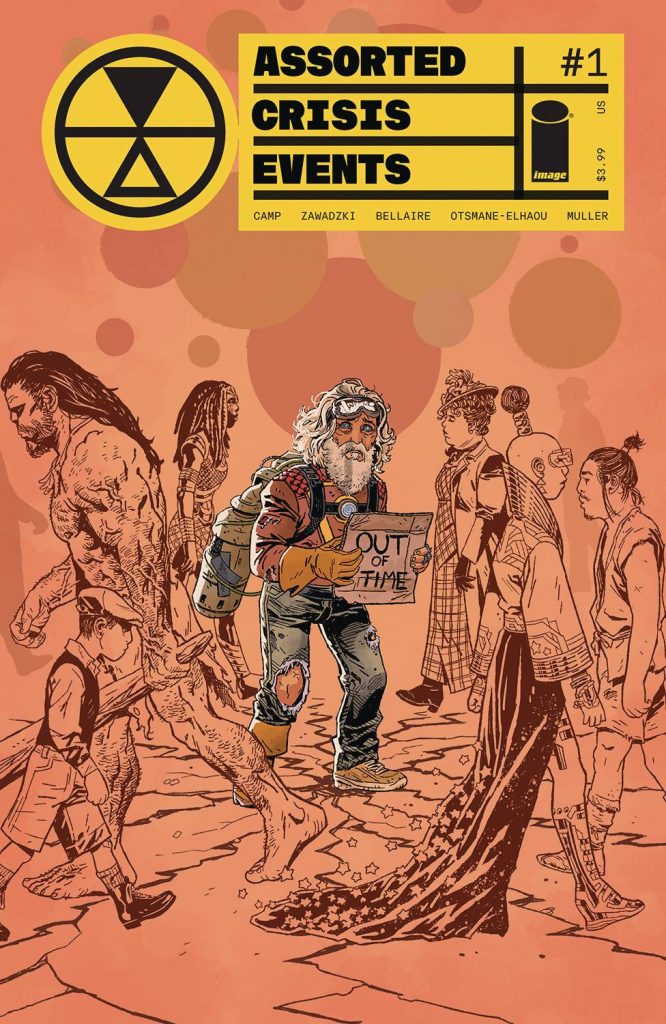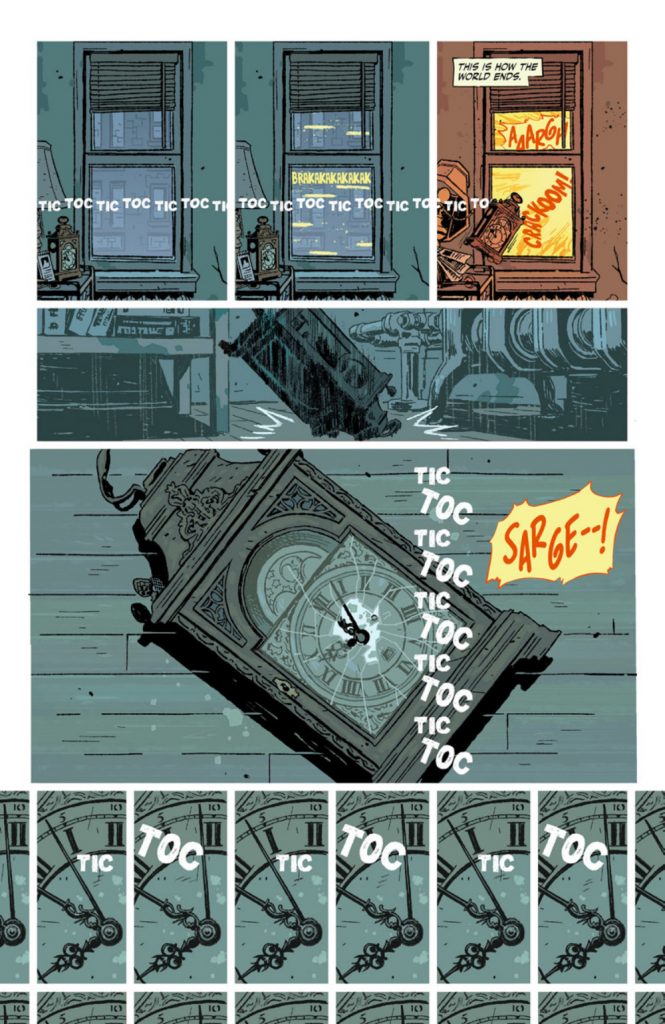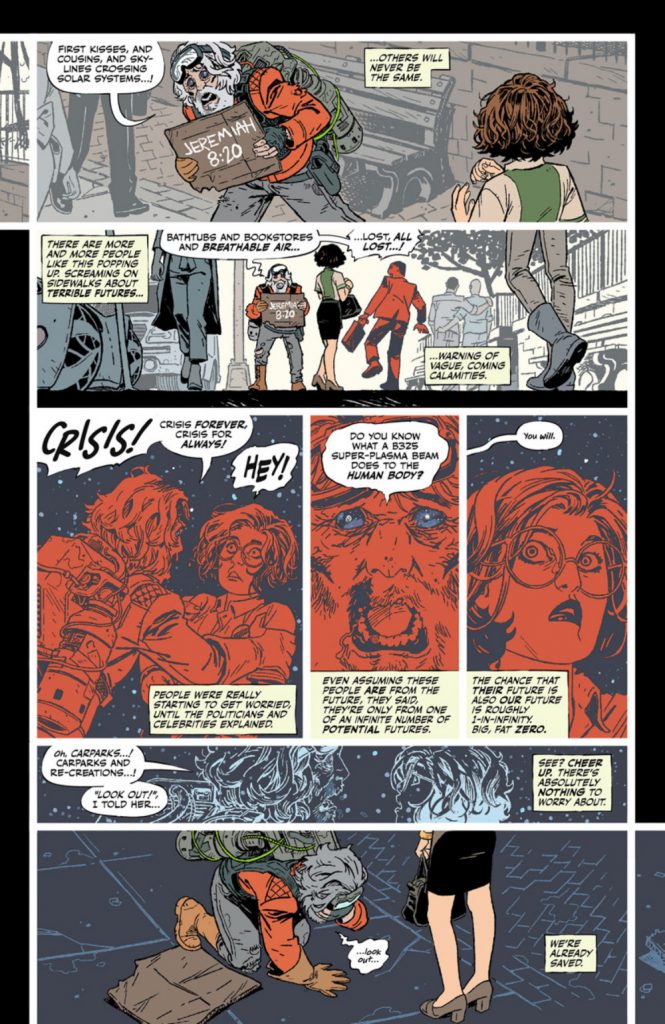Eric Zawadzki on the Art and Storytelling of his “Dream Project,” Assorted Crisis Events
If you’re a fan of comics with unconventional approaches that are filled with tremendous craft, you’re living large right now on Assorted Crisis Events alone. This Image Comics series zigs while everything else zags, delivering an idiosyncratic and deeply affecting read in an anthology that’s about the weight time has on us all. It’s sci-fi, but like the best examples of that genre, it’s very human, as writer Deniz Camp, artist Eric Zawadzki, colorist Jordie Bellaire, and letterer Hassan Otsmane-Elhaou find new ways to punch readers in the gut each issue as they deliver emotional stories unlike anything we’ve seen before. Needless to say, I am a bit of a fan of this series, even if it makes me feel like I need to reconsider my entire life after each read.
A big part of that is Zawadzki’s art. It’s a great concept that’s well executed, but it needed a unique talent to bring the whole thing to life visually. Zawadzki’s a perfect fit, someone who has long shown rare gifts on projects like Eternal at Black Mask and Heart Attack at Skybound but maybe never found the perfect fit to highlight his full skillset. He’s found it here, though, as he’s absolutely crushing Assorted Crisis Events.
As tends to be the case, my love of the work made me want to talk with the artist. So we did just that recently, as we put together an art feature interview over email that is about his background as an artist, how he figured out his voice, finding the right fits for him, and more, before we discuss the decisions and process that led to four pages and one cover from Assorted Crisis Events coming to life. It’s a great chat with a phenomenal talent, as Zawadzki shares the mindset necessary to bring such a complicated project to life. I hope you dig it, and stay tuned for more as the series returns the first Wednesday of November.
Let’s start in the beginning. What came first for you, comics or art? And how connected have those two things always been for you?
Eric Zawadzki: I’m not entirely sure. I’ve probably been reading comics since I was 4 or 5 and that’s probably the same time I started drawing. It’s all connected! I can say that I love drawing comic pages much more than drawing covers or individual illustrations, so that probably speaks to my love of comics overall and how much of my love of drawing is connected to this medium.

How did you figure out your artistic voice? Did you go to art school? Are you self-trained? What guided you in becoming the comic artist you wanted to be?
Zawadzki: I’m self taught, but I wish I had gone to school for illustration. It probably would have saved me so much more time. I drew five or six graphic novels before anyone was willing to pay me to do this, so it took me quite a while. And it took most of those attempts to find my voice. I suppose stubbornness and a love for the medium was my guide.
You’ve worked on a number of different projects at a number of different publishers over the years. At this point, do you have a sense of the types of stories you want to tell in comics? Or do you like throwing yourself curveballs to push yourself sometimes?
Zawadzki: I can say without a doubt that the types of stories that I want to tell are within Assorted Crisis Events. Every script is a new curveball. Every issue is a new challenge. It can be a struggle and sometimes frustrating as I try to figure out how to make things work, but it’s never dull and it’s always fulfilling. And my goal since I started taking this calling seriously has always been to be on a lengthy creator-owned comic, so I’m hoping that this dream book can last for a good long while.
I know you and Deniz Camp had a connection before Assorted Crisis Events because I once ran into him at your table at Emerald City Comic Con. So, the relationship was there, at least to some degree. But how did Assorted Crisis Events come together, and what was the appeal of taking it on?
Zawadzki: I met Deniz at New York Comic Con in 2017, shortly after my indie comic The Dregs came out. We hit it off immediately. As a creator, you meet a lot of fellow creatives at these conventions and for the most part people are really nice and a lot of good friendships are made. But every now and then you meet a fellow creative that you really vibe with and he was definitely that for me. We became fast friends. I think Deniz and I want the same thing out of comics.
I was busy for several years doing a 12-issue series at Skybound, Heart Attack, and a trilogy of YA graphic novels, House of El, at DC. But through all of that, we talked frequently. It felt inevitable that Deniz and I would create something together.
After I finished book three of House of El, I approached Deniz about developing something together. I sent him a mood board PDF, a collection of images, to give him an idea of what I wanted to do. And we started developing something, but in the midst of that he told me about other ideas he had on the go and one in particular really stuck with me. I remember not being able to sleep that night, thinking about the project. The next day I told him that I wanted to work on that project instead of the one we had done some development on. Thus was born our collaboration on Assorted Crisis Events.

I want to start by talking about the first page of the series itself. In the grand scheme of things, it’s not the showiest of pages, but it also is an exceptional expression of the type of storytelling you all are going to bring to these pages. I wanted to start with time. Time is essential to this entire series. How much does the visualization and manipulation of time play into everything you do on this page and this series?
Zawadzki: You have very little control over the time a reader puts into reading a comic. They can choose to read it slowly or speed read it. But there are little tricks you can do as an artist and storyteller to manipulate the reader into slowing down or speeding up. I’ve always been fascinated by that. I think this first page is a showcase of some of those tricks and it’s a way of showing the readers what they’re getting into with the overall series. And to speak to Deniz’s writing, it’s such a brilliant first page for a series about time being broken. He has a knack for finding that perfect first and last page for these stories.
You’re working with letterer Hassan Otsmane-Elhaou on this series. Your contributions to this series mesh impossibly well together. Did you two talk about how to best mesh your art and his lettering in this series at all? And are you handling the sound effects or is that him?
Zawadzki: When you’re collaborating with a genius like Hass, you don’t need to communicate much. He’s one of the best in the business. I absolutely love getting a PDF with his first pass at lettering an issue. It’s such a treat seeing all the fun decisions he’s made.
I do about 90% of the sound effects. Because I wanted to develop that skillset. I look at Alex Toth’s sound effects lettering and it looks so great. It’s so clearly hand drawn and clearly internally imperfect. There’s such charm to how improvised it looks. And how he doesn’t care if each repeated letter perfectly matches each other.
When you’re putting a page together, do you think of the page as a full composition — i.e. with letters and colors in mind — or do you exclusively think of the parts that you directly handle?
Zawadzki: With every issue, I create a very rough version of the comic with rough lettering so that Deniz and I can read it several times to see what’s working and what’s not. I always admired that Pixar’s approach to making a movie was different from a regular Hollywood film. They essentially make the film four or five times before they make the final version. And that allows them to work out all the problems before the final film is created.

I want to ask about the end of the world guy. I don’t even know what to call him, but in a series that’s an anthology by nature, he’s the one recurring character. What went into designing him? Is he someone you and Deniz talked about a lot in the development, or is that something that was entirely left to you to figure out?
Zawadzki: I’m not sure how much I want to reveal. Part of me wants to keep a lot of the behind-the-scenes stuff mysterious because there’s a beauty in people discovering their own interpretations.
I’ll just say that the character wasn’t there in the initial pitch. He came about from a discussion between me and Deniz.
As for his name, he has a couple of names. The way I see it, he has a sort of urban legend name in the comic and then there’s his actual name. That ‘urban legend’ name pops up in the issue I’m drawing right now. So expect some answers in the second arc!
This page is filled with some excellent and dramatic character acting, which is another thing you excel at. What’s the key to good character acting in your mind? Do you have a tried-and-true approach or method to it, or does it all really depend on the situation?
Zawadzki: A lot of the individual physicality or acting of each character comes out naturally. As I work through an issue, I’ll draw layouts and I find that I slowly discover the character as I go. It can end up being intuitive. Oftentimes I’ll be drawing and think that a pose just doesn’t feel right for the character because in the back of my mind I know they should be moving in a different way. As an example, I discovered over time that the lead character of the current script I’m working on is always hunched over. I made the decision that his lifestyle and work situation led to a bad back and bad posture.
subscribers only.
Learn more about what you get with a subscription
